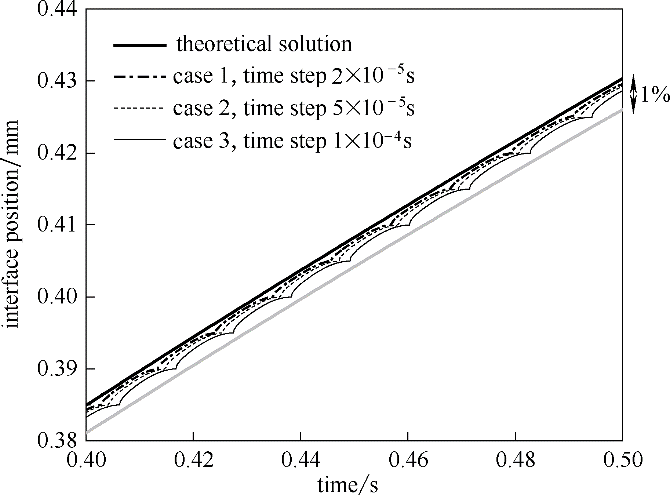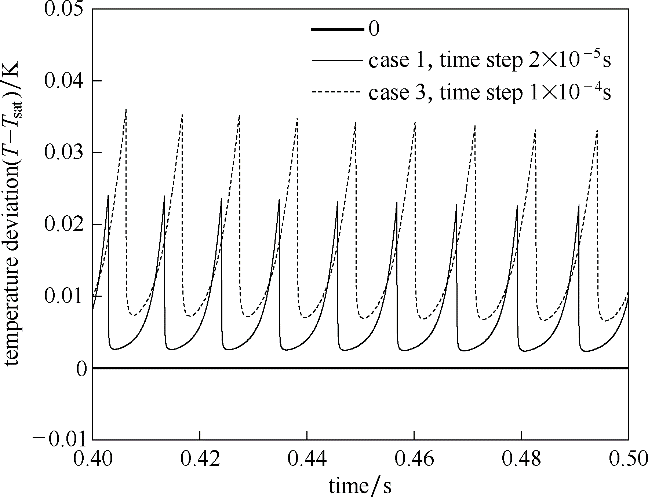化工学报 ›› 2020, Vol. 71 ›› Issue (S2): 62-69.DOI: 10.11949/0438-1157.20200663
收稿日期:2020-05-28
修回日期:2020-06-19
出版日期:2020-11-06
发布日期:2020-11-06
通讯作者:
闫孝红
作者简介:陈光(1995—),男,博士研究生,基金资助:Received:2020-05-28
Revised:2020-06-19
Online:2020-11-06
Published:2020-11-06
Contact:
Xiaohong YAN
摘要:
提出了一种基于VOF(volume of fluid)方法的相变模型,用于计算气液相变过程的控制方程中的传热传质源项。在单位时间步长上相界面附近发生的传热以瞬态热扩散来考虑,并假设该传热导致了相变的发生。相变模型能够通过相界面单元的温度、流体热物性以及时间步长来计算传热传质源项。通过一维Stefan问题和二维水平膜沸腾问题对该相变模型进行验证,对比了相界面位置以及温度分布,结果与理论解吻合良好。进一步探讨了相变模型中的时间步长对计算精度的影响。结果表明时间步长越小,本相变模型模拟得到的结果与理论解的偏差越小。
中图分类号:
陈光, 闫孝红. 一种模拟气液相变过程的相变模型[J]. 化工学报, 2020, 71(S2): 62-69.
Guang CHEN, Xiaohong YAN. A phase change model for simulation of vapor-liquid phase change process[J]. CIESC Journal, 2020, 71(S2): 62-69.
| 项目 | 密度ρ/(kg/m3) | 黏度μ/(Pa·s) | 比热容cp/(J/(kg·K)) | 热导率k/(W/(m·K)) | 汽化潜热hlv/(J/kg) | 表面张力系数 σlv/(N/m) |
|---|---|---|---|---|---|---|
| 气相 | 0.597 | 1.26×10-5 | 2030 | 0.025 | 2.26×106 | 0.059 |
| 液相 | 958.4 | 2.8×10-4 | 4216 | 0.679 |
表1 在101.3 kPa下水与水蒸气的物性
Table 1 Physical properties of water and steam at 101.3 kPa
| 项目 | 密度ρ/(kg/m3) | 黏度μ/(Pa·s) | 比热容cp/(J/(kg·K)) | 热导率k/(W/(m·K)) | 汽化潜热hlv/(J/kg) | 表面张力系数 σlv/(N/m) |
|---|---|---|---|---|---|---|
| 气相 | 0.597 | 1.26×10-5 | 2030 | 0.025 | 2.26×106 | 0.059 |
| 液相 | 958.4 | 2.8×10-4 | 4216 | 0.679 |
| 编号 | 网格尺寸/μm | 时间步长/s |
|---|---|---|
| 1 | 5 | 2×10-5 |
| 2 | 5 | 5×10-5 |
| 3 | 5 | 1×10-4 |
| 4 | 10 | 2×10-5 |
表2 Stefan问题计算案例
Table 2 Calculation cases of Stefan problem
| 编号 | 网格尺寸/μm | 时间步长/s |
|---|---|---|
| 1 | 5 | 2×10-5 |
| 2 | 5 | 5×10-5 |
| 3 | 5 | 1×10-4 |
| 4 | 10 | 2×10-5 |

图4 不同计算时间步长下Stefan问题0.4~0.5 s内相界面位置随时间变化结果
Fig.4 Interface position varying with time of Stefan problem from 0.4 s to 0.5 s under different time steps

图5 不同计算时间步长下Stefan问题相界面单元温度偏离饱和温度随时间变化情况
Fig.5 Deviation between interfacial cell temperature and saturation temperature with time under different time steps
| 项目 | 密度ρ/ (kg/m3) | 黏度μ/ (Pa·s) | 比热容cp/ (J/(kg·K)) | 热导率k/ (W/(m·K)) |
|---|---|---|---|---|
| 气相 | 5 | 0.005 | 200 | 1 |
| 液相 | 200 | 0.1 | 400 | 40 |
表3 二维水平膜沸腾问题气液物性
Table 3 Properties of vapor and liquid in two-dimensional horizontal film boiling problem
| 项目 | 密度ρ/ (kg/m3) | 黏度μ/ (Pa·s) | 比热容cp/ (J/(kg·K)) | 热导率k/ (W/(m·K)) |
|---|---|---|---|---|
| 气相 | 5 | 0.005 | 200 | 1 |
| 液相 | 200 | 0.1 | 400 | 40 |
| 1 | Kharangate C R, Mudawar I. Review of computational studies on boiling and condensation [J]. Int. J. Heat Mass Transfer, 2017, 108(A): 1164-1196. |
| 2 | Gibou F, Chen L G, Nguyen D, et al. A level set based sharp interface method for the multiphase incompressible Navier-Stokes equations with phase change [J]. J. Comput. Phys., 2007, 222(2): 536-555. |
| 3 | Sun D L, Xu J L, Wang L. Development of a vapor-liquid phase change model for volume-of-fluid method in Fluent [J]. Int. Commun. Heat Mass Transfer, 2012, 39(8): 1101-1106. |
| 4 | 孙东亮, 徐进良, 王丽. 求解两相蒸发和冷凝问题的气液相变模型 [J]. 西安交通大学学报, 2012, 46(7): 7-11. |
| Sun D L, Xu J L, Wang L. A vapor-liquid phase change model for two-phase boiling and condensation [J]. Journal of Xi􀆳an Jiaotong University, 2012, 46(7): 7-11. | |
| 5 | Sun D L, Xu J L, Chen Q C. Modeling of the evaporation and condensation phase-change problems with Fluent [J]. Numer. Heat Transfer Part B - Fundam., 2014, 66(4): 326-342. |
| 6 | Perez-Raya I, Kandlikar S G. Numerical modeling of interfacial heat and mass transport phenomena during a phase change using ANSYS-Fluent [J]. Numer. Heat Transfer Part B-Fundam., 2016, 70(4): 322-339. |
| 7 | Sato Y, Ničeno B. A sharp-interface phase change model for a mass-conservative interface tracking method [J]. J. Comput. Phys., 2013, 249: 127-161. |
| 8 | Tsui Y Y, Lin S W, Lai Y N, et al. Phase change calculations for film boiling flows [J]. Int. J. Heat Mass Transfer, 2014, 7: 745-757. |
| 9 | Perez-Raya I, Kandlikar S G. Discretization and implementation of a sharp interface model for interfacial heat and mass transfer during bubble growth [J]. Int. J. Heat Mass Transfer, 2018, 116: 30-49. |
| 10 | Schrage R W. A Theoretical Study of Interphase Mass Transfer [M]. New York: Columbia University Press, 1953. |
| 11 | Tanasawa I. Advances in condensation heat transfer [J]. Advances in Heat Transfer, 1991, 21: 55-139. |
| 12 | Lee W H. A Pressure Iteration Scheme for Two-Phase Flow Modeling [M]// Multi-phase Transport: Fundamentals, Reactor Safety, Applications. Washington, DC: Hemisphere Publishing, 1980. |
| 13 | Yang Z, Peng X F, Ye P. Numerical and experimental investigation of two phase flow during boiling in a coiled tube [J]. Int. J. Heat Mass Transfer, 2008, 51(5/6): 1003-1016. |
| 14 | Kim D G, Jeon C H, Park I S. Comparison of numerical phase-change models through Stefan vaporizing problem [J]. Int. Commun. Heat Mass Transfer, 2017, 87: 228-236. |
| 15 | Gorlé C, Lee H, Houshmand F, et al. Validation study for VOF simulations of boiling in a microchannel [C]//ASME International Technical Conference & Exhibition on Packaging & Integration of Electronic & Photonic Microsystems Collocated with the ASME International Conference on Nanochannels. 2015. |
| 16 | de Schepper S C K, Heynderickx G J, Marin G B. Modeling the evaporation of a hydrocarbon feedstock in the convection section of a steam cracker [J]. Comput. Chem. Eng., 2009, 33(1): 122-132. |
| 17 | Hirt C W, Nichols B D. Volume of fluid (VOF) method for the dynamics of free boundaries [J]. J. Comput. Phys., 1981, 39(1): 201-225. |
| 18 | Brackbill J U, Kothe D B, Zemach C. A continuum method for modeling surface tension [J]. J. Comput. Phys., 1992, 100(2): 335-354. |
| 19 | Deen W M. Analysis of Transport Phenomena [M]. New York/Oxford: Oxford University Press, 1998. |
| 20 | Welch S W J, Wilson J. A volume of fluid based method for fluid flows with phase change [J]. J. Comput. Phys., 2000, 160(2): 662-682. |
| 21 | Alexiades V, Solomon A D. Mathematical modeling of melting and freezing processes [J]. Journal of Solar Energy Engineering, 1993, 115(2): 121. |
| 22 | Agarwal D K, Welch S W J, Biswas G, et al. Planar simulation of bubble growth in film boiling in near-critical water using a variant of the VOF method [J]. J. Heat Transfer, 2004, 126(3): 329-338. |
| 23 | Ding S T, Luo B, Li G. A volume of fluid based method for vapor-liquid phase change simulation with numerical oscillation suppression [J]. Int. J. Heat Mass Transfer, 2017, 110: 348-359. |
| 24 | Akhtar M W, Kleis S J. Boiling flow simulations on adaptive octree grids [J]. Int. J. Multiphase Flow, 2013, 53: 88-99. |
| 25 | 曹志柱, 孙东亮, 魏进家, 等. 基于非结构化VOSET方法的沸腾传热[J]. 科学通报, 2020, 65(17): 1723-1733. |
| Cao Z Z, Sun D L, Wei J J, et al. Boiling heat transfer by using the VOSET method based on unstructured grids [J]. Chinese Science Bulletin, 2020, 65(17): 1723-1733. | |
| 26 | Klimenko V V. Film boiling on a horizontal plate — new correlation [J]. Int. J. Heat Mass Transfer, 1981, 24: 69-79. |
| 27 | Berenson P J. Film-boiling heat transfer from a horizontal surface [J]. J. Heat Transfer, 1961, 83(3): 351-356. |
| [1] | 宋嘉豪, 王文. 斯特林发动机与高温热管耦合运行特性研究[J]. 化工学报, 2023, 74(S1): 287-294. |
| [2] | 张思雨, 殷勇高, 贾鹏琦, 叶威. 双U型地埋管群跨季节蓄热特性研究[J]. 化工学报, 2023, 74(S1): 295-301. |
| [3] | 宋瑞涛, 王派, 王云鹏, 李敏霞, 党超镔, 陈振国, 童欢, 周佳琦. 二氧化碳直接蒸发冰场排管内流动沸腾换热数值模拟分析[J]. 化工学报, 2023, 74(S1): 96-103. |
| [4] | 叶展羽, 山訸, 徐震原. 用于太阳能蒸发的折纸式蒸发器性能仿真[J]. 化工学报, 2023, 74(S1): 132-140. |
| [5] | 张双星, 刘舫辰, 张义飞, 杜文静. R-134a脉动热管相变蓄放热实验研究[J]. 化工学报, 2023, 74(S1): 165-171. |
| [6] | 张龙, 宋孟杰, 邵苛苛, 张旋, 沈俊, 高润淼, 甄泽康, 江正勇. 管翅式换热器迎风侧翅片末端霜层生长模拟研究[J]. 化工学报, 2023, 74(S1): 179-182. |
| [7] | 张义飞, 刘舫辰, 张双星, 杜文静. 超临界二氧化碳用印刷电路板式换热器性能分析[J]. 化工学报, 2023, 74(S1): 183-190. |
| [8] | 王志国, 薛孟, 董芋双, 张田震, 秦晓凯, 韩强. 基于裂隙粗糙性表征方法的地热岩体热流耦合数值模拟与分析[J]. 化工学报, 2023, 74(S1): 223-234. |
| [9] | 江河, 袁俊飞, 王林, 邢谷雨. 均流腔结构对微细通道内相变流动特性影响的实验研究[J]. 化工学报, 2023, 74(S1): 235-244. |
| [10] | 吴延鹏, 刘乾隆, 田东民, 陈凤君. 相变材料与热管耦合的电子器件热管理研究进展[J]. 化工学报, 2023, 74(S1): 25-31. |
| [11] | 刘远超, 关斌, 钟建斌, 徐一帆, 蒋旭浩, 李耑. 单层XSe2(X=Zr/Hf)的热电输运特性研究[J]. 化工学报, 2023, 74(9): 3968-3978. |
| [12] | 陈哲文, 魏俊杰, 张玉明. 超临界水煤气化耦合SOFC发电系统集成及其能量转化机制[J]. 化工学报, 2023, 74(9): 3888-3902. |
| [13] | 宋明昊, 赵霏, 刘淑晴, 李国选, 杨声, 雷志刚. 离子液体脱除模拟油中挥发酚的多尺度模拟与研究[J]. 化工学报, 2023, 74(9): 3654-3664. |
| [14] | 胡建波, 刘洪超, 胡齐, 黄美英, 宋先雨, 赵双良. 有机笼跨细胞膜易位行为的分子动力学模拟研究[J]. 化工学报, 2023, 74(9): 3756-3765. |
| [15] | 赵佳佳, 田世祥, 李鹏, 谢洪高. SiO2-H2O纳米流体强化煤尘润湿性的微观机理研究[J]. 化工学报, 2023, 74(9): 3931-3945. |
| 阅读次数 | ||||||
|
全文 |
|
|||||
|
摘要 |
|
|||||
 京公网安备 11010102001995号
京公网安备 11010102001995号
